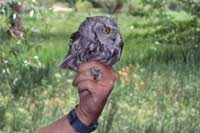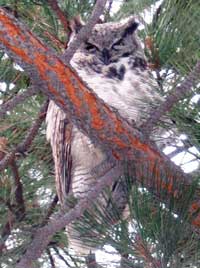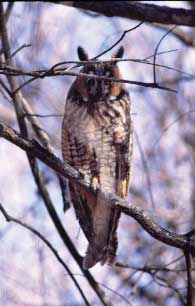Eared Owls of Canyon Country |
|
 My association between wildlife and the month of February, centers on screech-owls for one main reason. These small owls nested in our neighborhood, using tree cavities or nest boxes to raise their young. In this Old Town urban area, I could hear the “bouncing ball rhythm” vocalizations of these owls – a series of hollow, whistled notes ending in a rapid trill – as I wandered through our house with a newborn in my arms. My association between wildlife and the month of February, centers on screech-owls for one main reason. These small owls nested in our neighborhood, using tree cavities or nest boxes to raise their young. In this Old Town urban area, I could hear the “bouncing ball rhythm” vocalizations of these owls – a series of hollow, whistled notes ending in a rapid trill – as I wandered through our house with a newborn in my arms.By day, the little owls would be roosting in the cavities or perched on a branch, their cryptic coloration making observing them difficult. They might fly across the backyard if they were disturbed from these day roosts, but rarely did I see them. No, the nocturnal hours belonged to these owls. Across the state line in Grand Junction, Colorado, they too have screech-owls nesting in town. The local Audubon Society there undertook a survey one year to estimate the screech-owl population in the valley. Searchers used taped vocalizations that were broadcast in neighborhoods and small woodlots in the valley. From an initial estimate of several birds, determined from Christmas Bird Counts, the surveyors got over 100 responses from owls in different locations in town. Seek and ye shall find.  But western screech-owls, with their small ear tufts, aren’t the only eared owls to inhabit the canyons of Southern Utah. Great horned owls, named for their huge ear tufts, are one of the largest and most fierce looking owls in the region. Big and bold, these owls prey upon hares, rabbits, squirrels, skunks, prairie dogs, mice, porcupines, and even domestic cats that spend time outdoors. These owls have the classic deep hoots with a mnemonic that sounds like Who’s Awake, me too. But western screech-owls, with their small ear tufts, aren’t the only eared owls to inhabit the canyons of Southern Utah. Great horned owls, named for their huge ear tufts, are one of the largest and most fierce looking owls in the region. Big and bold, these owls prey upon hares, rabbits, squirrels, skunks, prairie dogs, mice, porcupines, and even domestic cats that spend time outdoors. These owls have the classic deep hoots with a mnemonic that sounds like Who’s Awake, me too.The great horneds nest in old redtail or raven nests, cliff ledges, alcoves or broken off tree trunks. One of the first birds to start nesting in the year, they may be incubating eggs as early as late winter. Sometimes I’d heard these owls behind our house, up on the cliffs above the Senior Center.  Another “eared” owl in the region is the long-eared owl. Like the great horned, the long-eareds have large ear tufts as well, but these owls are smaller in size and have an orangish facial disk. In winter, these owls may roost communally in willow or juniper thickets. During the breeding season they use old magpie, crow or raven nests. Their drawn-out hoots sound like “Whhoot!”, but the birds have a wide repertoire of sounds like screeches, barks and whistles that they employ for different situations. Another “eared” owl in the region is the long-eared owl. Like the great horned, the long-eareds have large ear tufts as well, but these owls are smaller in size and have an orangish facial disk. In winter, these owls may roost communally in willow or juniper thickets. During the breeding season they use old magpie, crow or raven nests. Their drawn-out hoots sound like “Whhoot!”, but the birds have a wide repertoire of sounds like screeches, barks and whistles that they employ for different situations.All these eared owls occur in the Moab and Spanish valleys. I have seen long-eareds nesting in the Matheson Wetlands and in close proximity to nesting Cooper’s hawks, while the screech-owls were also nearby. Of course, all of these owls are going to give the great horned their space, because the great horned could predate upon these smaller owls. Just because one is on the predator list doesn’t mean they are exempt from the prey list. Though these are “eared” owls, this refers to the ear tufts on top of their heads. The tufts don’t facilitate hearing, but add to facial expressions and break up the bird’s silhouette. The ear openings are located on the sides of the head and are somewhat offset to help triangulate sound. Sometimes when I would hear these winter owls calling, I’d walk outside with my infant daughter and let parenthood mix with the sounds of nature.
|
